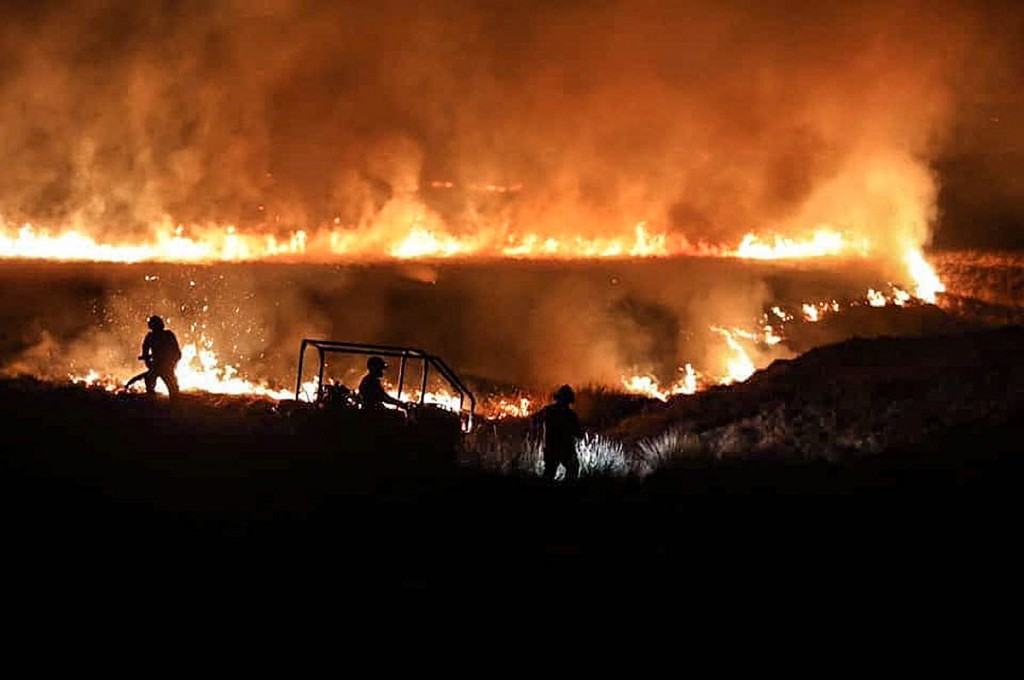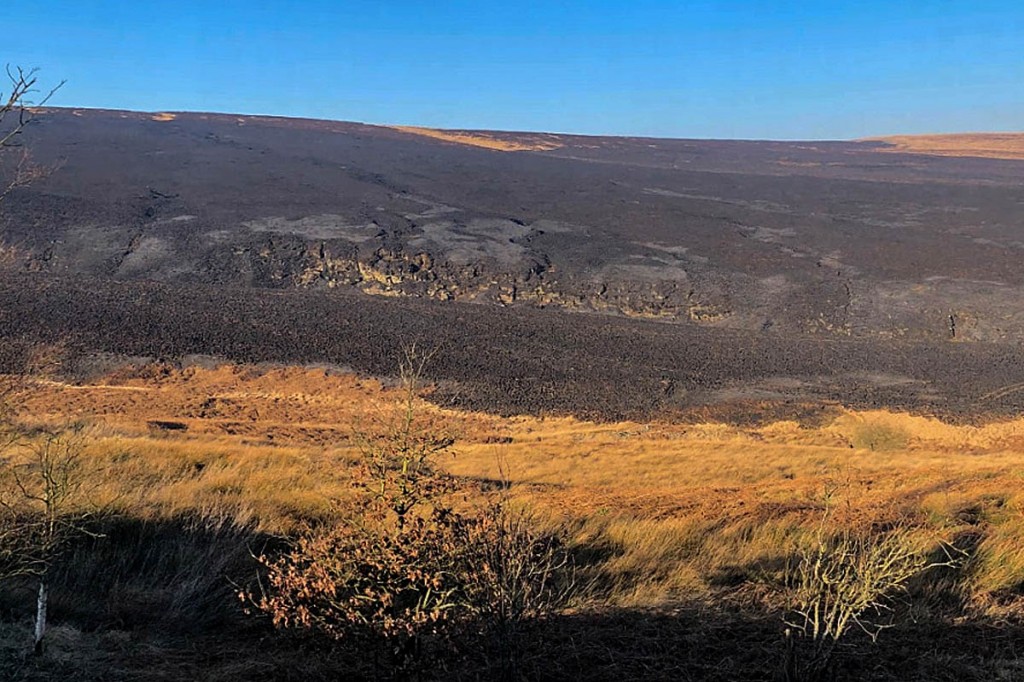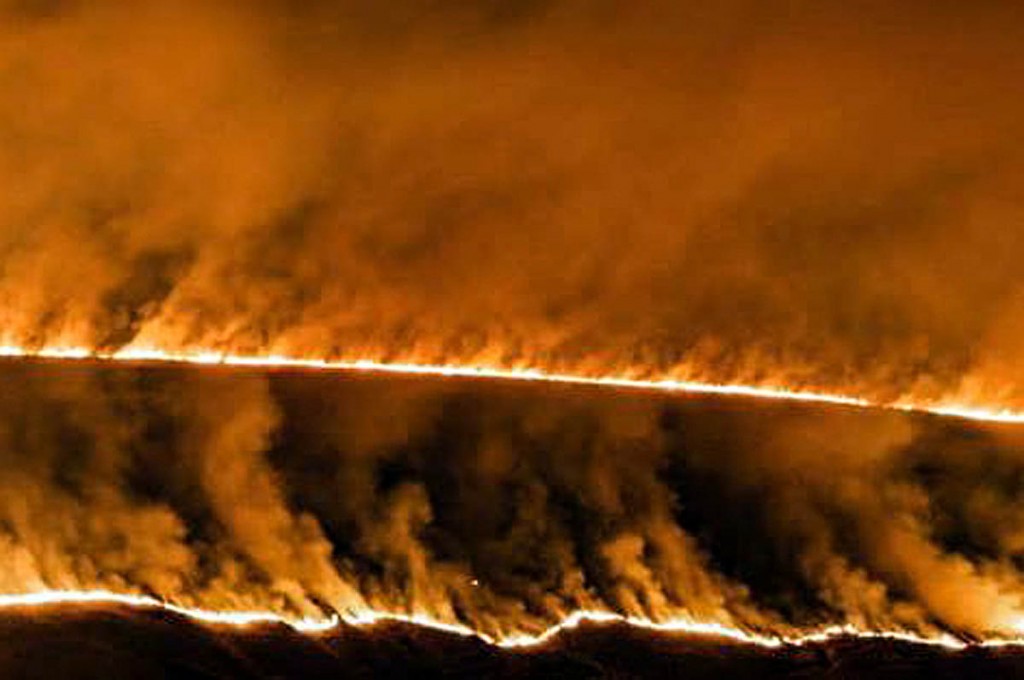
Firefighters in action during the Marsden Moor wildfire. Photo: West Yorkshire Fire & Rescue Service
Peak District bosses are urging outdoor enthusiasts to take care after a huge overnight moorland blaze in the national park.
Freakishly warm and dry winter weather has created an unusual fire risk, the national park authority said.
About 30 firefighters tackled the wildfire on Marsden Moor in the north-eastern part of the Peak District. There were also two smaller fires in the Dove Stone area on Saddleworth Moor.
West Yorkshire Fire and Rescue Service said the Marsden Moor blaze covered about 3-4 sq km of ground and firefighters faced one of the highest flame fronts they had ever encountered, which was moving rapidly across the surface of the moor.
The fire service was alerted about 7.50pm on Tuesday. Fire engines from Slaithwaite, Huddersfield, Todmorden, Meltham, Holmfirth and Skelmanthorpe went to the scene, along with one from Chadderton, from Manchester Fire and Rescue Service.
A spokesperson said firefighting conditions were very difficult. Station Manager Adam Greenwood, who attended the fire overnight, said: “When crews arrived shortly before 8pm there was a large area of approximately about 3-4 sq km of moorland on fire.
“It was one of the of the highest flame fronts we have seen with flames of up to two metres high and it was moving fast across the moorland.
“The top layer of the moorland is quite dried out because of the recent good weather and underneath is quite damp so it has run across the surface of dry vegetation.
“Two specialist wildfire units were there and approximately 30 firefighters tackling the fire. It was really adverse conditions. We were rotating the crews for their welfare as it’s very physically demanding work.
“Crews were walking up to a mile to reach the fire and were carrying blowers, beaters and other firefighting equipment with them. Crews have worked tirelessly to get the fire under control and have done a great job.
“The quick initial fire attack by firefighters did help to bring the fire under control, despite the size and ferocity of the flames.”
Crews monitored the spread of the fire but no buildings had to be evacuated. The fire remained a distance of around 500m from Manchester Road.
The fire had died down by about 3am on Wednesday but crews remained at the scene, with five fire engines at the site by early morning including the Keighley wildfire unit.
Station Manager Greenwood said: “The fire looks to be out. However, moorland fires can easily reignite so it’s important that we monitor it closely.
“We have five pumps still at the scene along with two wildlife units to tackle any hotspots that might arise as the day goes on. We are also working with the National Trust and the Marsden rangers who will remain at the scene with us. We expect to be at the moors for much of the day.”
The Peak District National Park Authority asked walkers and other visitors to be ‘fire aware’ during the warm, dry period.

The devastated moorland after the fire had been put out. Photo: West Yorkshire Fire & Rescue Service
A spokesperson said: “The moorlands of the Peak District National Park are of global environmental importance, dominated by large expanses of blanket bog and upland heath.
“We must protect these moorlands from the considerable risk of damage by wildfires. We work throughout the year with partners, including landowners, fire and rescue services and local farmers, to monitor conditions and ensure that teams can respond to incidents effectively when they occur.”
The wildfire risk in areas such as the national park is assessed by the fire severity index, based upon a number of criteria analysed by the Met Office. In recent days this has been between low and medium risk.
An authority spokesperson added: “As the recent warm spell means visitors may be enjoying activities we might otherwise associate with the summer months, which can carry a risk of fire, it is more important than ever that people take care and consider the potential impacts of wild fire when enjoying the outdoors.”
It said most wildfires are unintentional, caused through carelessness. The most common causes are: unextinguished or poorly managed barbecues; discarded cigarettes; litter, including glass which can cause intensified heat; and campfires.
Anyone who sees smoke or fire on the moors is asked to report it immediately to the fire and rescue service on 999.
